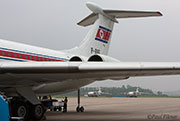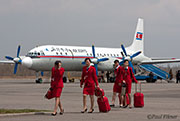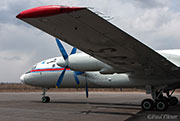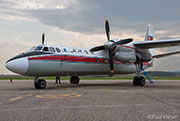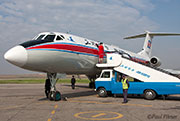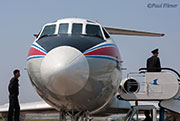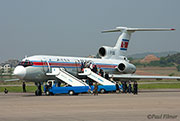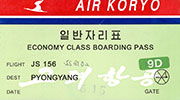I was alerted to a trip to the Democratic People's Republic of Korea (DPRK) via a newsgroup posting which promised the opportunity to fly on a variety of Soviet aircraft including the Il-62 and the Il-18. After doing a little research and talking to the tour organiser, David Thompson of Juche Travel Services (JTS) in London, I decided to take the plunge. Other operators have attempted aviation centric tours in the past, but photography of the aircraft involved had been almost impossible, so the chance of flights plus photo opportunities was a big pull for me.
All visits to the DPRK must be co-ordinated via the Korean International Tourism Company (KITC) which is a state run company that provides transport and guides, as you are still not allowed to travel inside the country independently.
The majority of visitors arrive via China, as only a handful of countries have flights to the DPRK, and Air Koryo has a small fleet with restricted routes due to sanctions and bans. Our tour would depart Beijing Capital Airport, and this is the major hub for such flights, with multiple sectors operating on some days. Other destinations served include Shenyang in China, Vladivostok in Russia and Bangkok in Thailand.
It would be remiss to not mention the long and complex changes that have happened to this country over the last century to put the current political climate into some kind of perspective. Japan annexed Korea from 1910 until the end of World War II, when Japan surrendered, and the country was divided at the 38th parallel by the United Nations, with the Soviet Union administering the North and the United States the South. Both Korean governments wanted to control the whole of the Korean peninsular, and border conflicts escalated over the years until a full-scale civil war broke out in 1950, the infamous Korean War.
This could also be described as the first armed conflict of the Cold War between the Soviet Union and the United States and created the idea of a proxy war, where the superpowers would fight in a remote country. The North managed to push almost all the way to the far south before eventually being forced back northwards. An armistice was signed in 1953 where the original border set in 1945 was re-established. Part of the deal was that Soviet and American forces were to leave the peninsular, but only the Soviets left in the end, leaving a large US presence in South Korea to this day.
After making our way to Beijing the adventure started. No one really knew how the access in the DPRK would pan out or if we'd even be allowed to take photos. My reason for going was two fold. Firstly I wanted to fly on two aircraft that I'd assumed were now long dead as passenger aircraft : the Il-62M, of which Air Koryo is now the last commercial passenger operator in the world, and the Il-18, which is only also operated in passenger configuration in Africa. Secondly I'm always fascinated by travelling to places off the beaten track, or a place that people simply don't visit. With only around 3000 Western visitors per year - the majority of tourists being from China - I wasn't sure if I'd see the country as it really was, or if we would be granted just get a small window on to this little known society.
The evening before the tour began I'd bumped into two people I already knew at our pre-tour dinner in Beijing where we would collect our visas, and I had already met up with Steve Kinder earlier in the day. There were also a few other familiar names that I knew from mail groups, and in all there were 30 of us taking this inaugural aviation trip organised by JTS.
On Saturday 12 May our Il-62 was already parked on its gate at Beijing Capital's Terminal 2, and luckily this is one of the gates where you're able to shoot through the glass when ready to board. Beijing airport is pretty relaxed about taking photos so we had no issues getting our shots, although the constant Beijing fog was in full effect. P-885 is an Il-62M delivered new in 1979 and is one of four Il-62s operated. Two are fitted out in VIP configuration.
I secured a rear right-hand window seat (25F) on flight JS152 to get the most of listening to the old engines, and, as we pushed back, the noise did not disappoint, the four Soloviev D-30 engines providing a suitably impressive sensation of power. The onboard public address system was weak at the rear due to the noise, as the cabin crew made sure all the passengers were seated and buckled in, with many passengers not seeming to understand the requirement to sit down as they fussed with luggage. As we lined up on the runway one stewardess was still sorting one elderly Chinese woman out.
Il-62 Startup
The last time I flew anything similar to the Il-62 was a British Airways VC10 back in 1981 on the final London to New York flight. The VC10 literally made you sink in your seat as it accelerated down the runway, but the Il-62 gave more of a gentle shove as we accelerated before rotating and beginning the characteristic shallow climb away from our departure point. The flight was extremely smooth and, at the top of descent into Pyongyang, the undercarriage was lowered to aid deceleration in typical Russian style, as would happen on all our subsequent flights.
Il-62 Takeoff
Il-62 Landing
So here we were in the DPRK with no idea of what would lie ahead. We were told in advance that ramp photography at Pyongyang might be tricky and we would have a better chance at the quieter outlying airfields we would be visiting later in the trip. As I exited the aircraft at the top of the steps, to descend onto the ramp, I looked around wondering if I should chance my arm and get my camera out. There were uniformed security personnel everywhere I looked, including some with dogs, but the picture looked all wrong as some of our group were already on the ramp and happily snapping away without so much as a second glance from anyone. Truth be told I really wasn't prepared for this freedom after all the stories that I'd heard, so I joined in and we tested the waters further by turning around and shooting the Tu-204 behind us along with the line up of some of the rest of the fleet; again, nobody batted an eyelid. Surreal.
We were finally ushered inside the terminal, where the customs and immigration formalities lay ahead of us. In our customs declaration we had to list all electronic devices, and we'd been warned ahead of time that our mobile phones would be taken away for collection on exit from the country. We were also told that long lenses had the chance of being taken away, but no attention was paid to my white Canon 70-200mm f/4 lens in my bag. The only two items that they wanted to see was my compact camera and my iPad. It seems that they are mostly concerned with devices that have GPS capabilities, which is the reason for the mobile phone confiscation. Apart from that all was very straightforward and cordial.
After a day to acclimatise, our first internal flight was due on Monday 14 May. An Il-18D had been chartered specially and would take us to an airport called Samjiyon in the north of the country on flight JS3101. We were told that only about 100 Western visitors per year travel into this area, as there are no scheduled aircraft services, and the only practical way is to fly. We were joined by a small group of people from another tour who took the opportunity of the flight to visit the area with us.
We first had a visit with an Air Koyro representative in the administration building who told us about the history of the airline and answered any questions we had. The state airline was formed in 1950 as Sokao as a joint Korean-Soviet venture to link North Korea with Moscow, but this was short lived due to the Korean War. The current airline started services in 1954 as the Civil Aviation Administration of Korea (CAAK also known as Chosonminhang). CAAK become Air Koryo in 1993 and still operates a mixed fleet of Russian built aircraft to this day.
The current inventory consists of over 40 aircraft including An-24, Il-18, Il-62, Mi-8/Mi-17, Tu-134, Tu-154, Tu-204 and Il-76 aircraft, and we would see examples of each on our trip.
P-835 was ready on the ramp on this drizzly and overcast day. This Il-18D was delivered to the operator from new in 1969. I had a window seat right at the front (1A), and when I boarded the captain was relaxing in my seat. The radio operator told me that the crew uses the first row to rest, but he had no issues moving for me. This aircraft operates with a crew of five; captain, second pilot, engineer, navigator and radio operator. In fact we had two flight crews on board, one to take us out, and the other to bring us back the next day. Air Koryo wanted a double crew with us as we were deemed important and they wanted all phases of the flight to be as safe as possible. This was also a new, unknown venture for the airline.
We took the long taxi out to Runway 01 at Pyongyang and then held while the props were exercised and synchronised before final checks took place. We lined up and the four Ivchenko AI-20 engines roared into life, and we were airborne in a short amount of time and in a characteristically shallow climb out. The flight was surprisingly smooth and quiet as we hummed along in this 43 year old airframe.
During the flight I had the opportunity to chat with the relief radio operator and asked him how he was selected to fly on the Il-18. He had studied foreign languages at university and had elected to go into this field after passing exams to see if he was suitable. He was assigned this particular Il-18 and this is the only aircraft he flies on. It's the same way for the rest of the flight crew. He may change in the future if someone is needed elsewhere, but for now this is his aircraft and the whole crew are very proud of the airframe. The captain had been flying P-835 for six years and told us he hopes to fly it for another ten years into his retirement.
55 minutes later and we touched down at Samjiyon airport. A glimpse of a couple of silver MiG-15UTI training aircraft were spotted through the trees for a second, and later, while we took the time to photograph the Il-18 on the ramp in glorious sunshine, we could hear a couple of the fighters engines running. Again we were shocked at the freedom we had at what is at least in part a military airfield. Luckily the sun was now shining and we were given ample opportunity to get all the photographic angles we wanted. We were also given the opportunity to take photos of the cockpit, and we would be offered that on all subsequent flights.
Il-18 Landing
We then sat and ate a packed lunch outside the small terminal overlooking the ramp as if this was the most natural thing in the world.
We saw some interesting sights, including an aborted attempt to get to Mount Peakdu due to snow on the road, during the rest of the day before retiring to a somewhat 'different' hotel. I would assume this was the only hotel for miles around, and it had set times that hot water would be available and when we arrived the electricity was off. The pillows were harder than the beds, but this was only one night so no big deal, in my book anyway, although there were grumbles from some of the group as per usual.
The next day after some morning sightseeing we arrived back at the airport for our flight back to Pyongyang, and of course to take some more photos on the ramp of our immaculate beast. We were all 'wanded' by security before boarding, and because the airport was so quiet the crew simply did a 180 turn from our parking spot onto the nearby Runway 07 to exercise the props and perform power checks, before taking off in the opposite direction to the way we landed the day before. There isn't actually a taxiway that larger aircraft can use, so you either land towards the terminal at one end, or backtrack the runway on landing.
Il-18 Takeoff
All of our flights used the easiest direction for take off and landing to minimise taxi time, as during the whole trip there was no wind to speak of, and of course with the limited flying done inside the country there is seldom any conflicting traffic.
After another smooth 1 hour 3 minute flight we were back in Pyongyang, and for the first time we saw sun at the country's capital.
An Il-14 had been spotted a couple of times and obviously we had mentioned to David that we'd like to shoot it. Many meetings and negotiations were ongoing in the background throughout the tour, and, as we disembarked the Il-18, we were told that the airport bus would take us to the Il-14 where we would have about one minute to get out, stay near the bus and photograph this rare machine that hadn't been seen before. After a couple of minutes it was decided that the extra non-aviation tour passengers should be taken to the terminal leaving us more time to get different angles in the perfect weather. So there we were on a remote ramp at Pyongyang Airport, with just a single security person plus one of our local tour guides, with an immaculate Il-14 in front of us. That was certainly one of the highlights and was most unexpected.
This Il-14 is painted as 535 and is presumed to be an-ex military machine. We were told that it was in fact an aircraft that Kim Il Sung used to fly in. It has been painted in old CAAK colours and is due to be moved to a permanent exhibition hall in the city sometime in the future.
Our next flight the following day (16 May) was on a chartered An-24 on a round-robin flight just for the heck of it. P-537 is an An-24B delivered new to CAAK in 1976. Unfortunately we spent most of the time in the clouds as the weather wasn't particularly inspiring, but we had fun anyway on our 57-minute interlude. On our return we took a few photos on the ramp and the bus came along to take us back to the terminal as we all salivated as a Tu-204 was taxying inbound. Most probably aware that they would have to deal with 30 aviation nuts blocking the entry to the terminal to the Tu-204 passengers as we took photos, we were whisked straight landslide via a gate, thwarting that particular photo opportunity.
An-24 Startup
The next day on 17 May it was time to fly the pocket rocket that is the Tu-134. This flight to Hamhung in the industrial east of the country was originally planned to be an An-24, but we had too many passengers for that, so the Tu-134 was chartered instead. Who am I to complain, as I thought I'd flown my last '134 two years ago. P-814 was built as a Tu-134B and is reportedly the last Tu-134B to be built in 1984. It was later upgraded to Tu-134B-3 standard.
Tu-134 Takeoff
The engine start didn't have the characteristic bangs as my previous Tu-134 flights have had, as this airframe, being part of the last batch off the production line, has three compressors inside the engines instead of the original two compressor layout. This made the start-up sequence much smoother. But still being low-bypass engines the roar on take-off still sounds like a fighter jet, and it still leaps into the air like a scalded cat.
We landed at Hamhung Airport to see lines and lines of military Y-5 (An-2) aircraft – 40 plus, I would guess. As we taxied in, a stream of four of these venerable machines took to the circuit, all touching down next to where we were parked. Yet again we were allowed to take photos on the ramp with strict instructions not to shoot the military aircraft in close proximity. Unfortunately the sky was white as it was drizzling with rain again, so photos of our Tu-134 weren't the best, but we would see our mount again the following day.
Tu-134 Landing
While in the city we saw a couple of MiG-21 fighters flying around from a different airfield, most likely Toksan AB.
When we arrived back the following day the sun was out but photos from the ramp next to the terminal suffered from heat haze and we were then bussed the short journey to our aircraft after security formalities. By now the security personnel had become a little nervous with all the cameras, so unfortunately we only had the opportunity to shoot the aircraft from the backlit side.
On the take-off a lone Li-2 was also seen, although this aircraft was not airworthy. 23 minutes out and 25 minutes return satisfied my lust for time on this, one of my favourite Soviet aircraft.
The final flight back to Beijing to conclude my time in North Korea was due to be on one of the Tu-204s, which is becoming a rare beast to fly on. 20 or so of the group elected to fly back to China on the Shengyan (SHE) service with is served by the Tu-154. We were told the day before that because of load factors the SHE service was due to be flown by an Il-62 and our Beijing service might possibly be the 154 instead, the extra 20 passengers in our group most probably caused the extra load factor ironically enough. This caused much gnashing of teeth and requests to change flights by many of the SHE group, but the flights couldn't be changed at such short notice. At least they'd get to fly on an Il-62 again.
On the day in question, 19 May, there were two flights to Beijing within 30 minutes of each other, and we were booked on the second flight at 09:30 (JS221). When we arrived at the terminal we learned the first flight was to be operated by a Tu-204 and the second flight by a Tu-154B-2. From my point of view either would be a new type for me to fly on, but with these being the only B-2 examples left in civilian service, it ended up being a nice bonus to wrap up the trip on.
Tu-154 Startup
P-561 was delivered new to CAAK in 1984, and the Tu-154 has its own unique sound at start up and the noise just builds and builds until the aircraft is ready to taxi. I was near the rear to get the full effect, of course! The flight to Beijing was an uneventful 1 hour and 40 minutes - a little longer than normal as we were put in a hold for a time. Again the undercarriage was lowered at the top of descent and, after exiting the hold, we flew straight and level at around 3-4000 feet for quite some time, undercarriage dangling and most likely intercepting the glide path from below, although that is pure speculation. As usual Beijing was shrouded in fog, as were all my days in the city.
Tu-154 Takeoff
After a full 20 minute taxi around what seemed like the whole of Beijing Capital Airport our adventure finally came to an end and we said our goodbyes.
Tu-154 Landing
Interesting? Yes. Surprising? Yes. Unexpected? Yes. Many of the facts purported by the Western media is frankly untrue, but the DPRK also engages in its own propaganda so the rhetoric goes both ways and the truth is somewhere in between.
We found all the people to be friendly and genuinely curious but also very willing to engage, especially the children who were wide-eyed and would always give us a wave if we instigated it. Restrictions on photography of normal life were largely unrestricted when compared to as recent as three months ago, according to David, so it seems like the country is slowly opening up, maybe due to the change in leader or maybe part of a larger plan that was already in place.
I'd recommend anyone to go and visit and gather the facts for themselves. I do realise that we may not have seen every facet of the country, but from what we saw conditions were no worse, and in many cases better than many Asian or South American countries that I've visited. It's certainly better to get first hand knowledge and experiences.
I'd like to thank David from JTS, our KITC tour guides and Air Koryo for their tireless work and negotiations in making everything happen. It was a new experience for us and was certainly the same for the airline.
I hear the next trip will also involve Il-76 and Mi-17 flights – we must have been behaved well enough for Air Koryo to open up even more!
Quote from the Korean Central News Agency about our tip:New Tourist Itineraries Proposed in DPRK
Pyongyang, October 8 (KCNA) -- The Democratic People's Republic of Korea has offered new tourist itineraries, drawing attention of foreign people.
Last May an airplane of the Koryo Air Company with European flight hounds aboard left Pyongya ng Airport for tour of Mt. Paektu. Those tourists also went sightseeing in the east coastal area in the country by another plane taking off at Samjiyon Airport. This was the first demonstration tourism by air for foreigners in the country.
Tourists can satisfy their curiosity through tour and photographing of airplanes of various types possessed by the company and use of them.
The company has various kinds of civilian airplanes. Those planes have been used for a long time, but their technical and external state is still kept fine.
Those tourists are satisfied with such air tourist service for diversity in air transport means and convenience in their use.
According to organizers of the tourism by air, flight tourist groups visited Pyongyang in May, July and September and another group of aviation enthusiasts is to arrive here in October.
Such tourism is expected to become more popular next year.
Subscribe to receive updates via: e-mail list | Facebook | Instragram | Twitter
Comments:3rd September 2014 matt smith
wow, would like to say thanks for posting, and jealous. Really great to see
the background in the photos, and its a good comparison to what early air travel looked like in the USA (different planes of course) but still what it was like here in the 1950's, 1960's in a strange sort of way...
16th January 2013 Rodger Cook
Great photos and video Paul, and a once in a lifetime opportunity. Thank you!
28th December 2012 Jason Hyatt
Thanks for the writeup, Skippy. It was a pleasure to read, and the wonderful and rare aircraft were a pleasure to view!
6th October 2012 John
Thanx for sharing enjoyed it alot !
5th October 2012 PAUL HAYWARD
Indeed it did, we did the mil17, IL76,AN24,IL62/IL18 AND tu134, we should have done the 154 but it was subbed with another il62..
Ace trip
4th October 2012 Matt
Awesome. Thanks for posting!
1st October 2012 Ryan Keough
Great write-up and photography as always Paul! It was a real eye opener for me and has generated a bit of enthusiasm for me this afternoon as I'd love to take part in a future tour as well! Just the opportunities to fly aboard such aircraft would be amazing in its own right!! Thanks for taking the time to share your experience with us!
1st August 2012 Craig
great read, thanks! I'll be on the Sept. tour. Cannot wait!
30th July 2012 H
I have just come back off the July trip, we flew, il18, il62,yu134,an24,mil 17 and the MIGHTY il76.... superb tours!!
H
29th July 2012 Curt Jans
Great writeup - extremely unique opportunities. Outstanding. Cheers, Curt
29th July 2012 John Kelly
Great tour report and photos! Thanks for sharing. Regards, JCK.
[photo/serial list]
